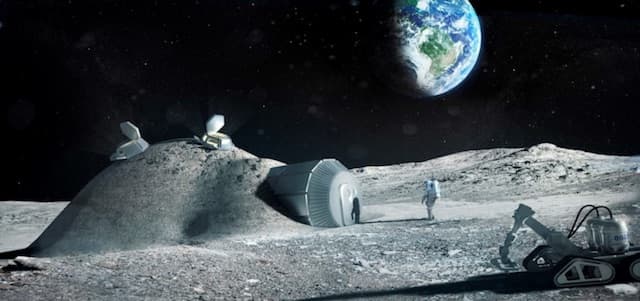NASA and Stanford engineers can create concrete using rocks on Moon or Mars
Colonizing distant planets is going to be the next big mission for humans. NASA is gearing up to send humans to the red planet by end of the next decade and entrepreneur Elon Musk believes that his company 'SpaceX' can do it in the next eight to ten years. It's clear that humans will conquer these planets in near future and back home, the preparations have already began. One of the first and important things humans will have to do is build abodes to live. But as anyone can guess, it's not just as easy as it is here on Earth.
Transporting tens of thousands of tons of cement is highly impractical; and even if we figure out a way to do that, the harsh radiation on these planets would burn holes into ordinary structure. Setting up a cement factory on these planets looks to be the only viable solution, and engineers at NASA and Stanford University have jointly developed a new technique that will allow us to do that. The new technique allows creating concrete using rocks on Moon and Mars.

Photo Credit: ESA
The technique makes use of animal protein that allows for creating a new form of concrete using raw material available on Mars or Moon. Researchers had to create environmental conditions similar to Mars and the Moon. First the animal protein was combined with extraterrestrial soil that is very similar to the one on Mars and the Moon. Then, in order to simulate the lower gravity, the mixing was done using vacuum technology.
The first batch of the concrete produced has strength that of concrete typically used for creating footpaths and it survived the constant bombardment of micrometeorites. Researchers simulated the attack of the micrometeorites using high-speed gas particles.
The overall production of concrete on distant planets will involve creation of biological factories of genetically engineered organisms. These organisms will provide the required protein to act as a binder. Michael Lepech, associate professor of civil and environmental engineering at Stanford says that the new concrete isn't ready for buildings yet, but it will be in future. Lepech and team found out that the cement would degrade if exposed to heavy rains for a period of few years.

Photo Credit: Mia Allende
There are multiple opportunities to make the cement production ready. Read full details on the source link below.
Source: #-Link-Snipped-#
Transporting tens of thousands of tons of cement is highly impractical; and even if we figure out a way to do that, the harsh radiation on these planets would burn holes into ordinary structure. Setting up a cement factory on these planets looks to be the only viable solution, and engineers at NASA and Stanford University have jointly developed a new technique that will allow us to do that. The new technique allows creating concrete using rocks on Moon and Mars.

Photo Credit: ESA
The technique makes use of animal protein that allows for creating a new form of concrete using raw material available on Mars or Moon. Researchers had to create environmental conditions similar to Mars and the Moon. First the animal protein was combined with extraterrestrial soil that is very similar to the one on Mars and the Moon. Then, in order to simulate the lower gravity, the mixing was done using vacuum technology.
The first batch of the concrete produced has strength that of concrete typically used for creating footpaths and it survived the constant bombardment of micrometeorites. Researchers simulated the attack of the micrometeorites using high-speed gas particles.
The overall production of concrete on distant planets will involve creation of biological factories of genetically engineered organisms. These organisms will provide the required protein to act as a binder. Michael Lepech, associate professor of civil and environmental engineering at Stanford says that the new concrete isn't ready for buildings yet, but it will be in future. Lepech and team found out that the cement would degrade if exposed to heavy rains for a period of few years.

Photo Credit: Mia Allende
There are multiple opportunities to make the cement production ready. Read full details on the source link below.
Source: #-Link-Snipped-#
0
